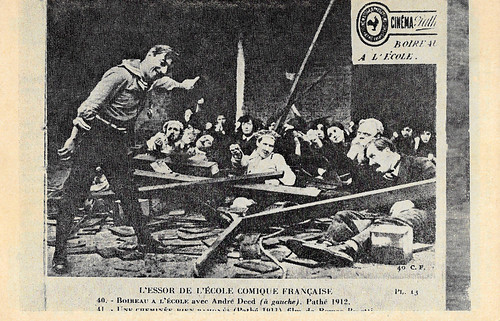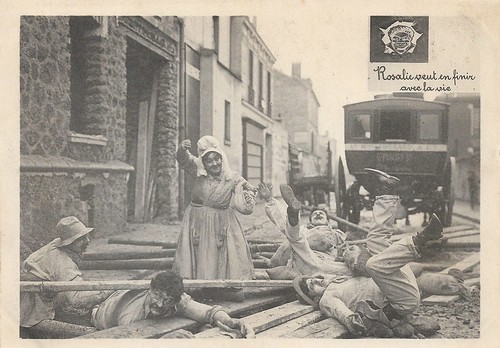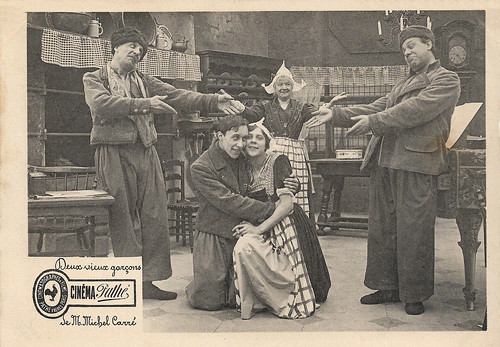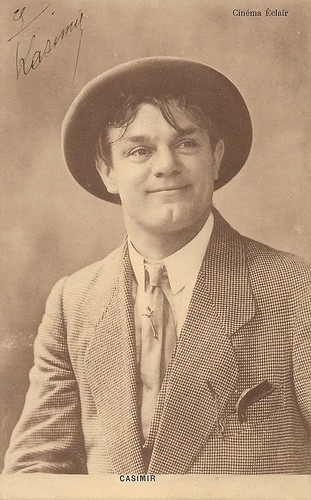
French postcard by Sadag de France, Imp., Paris, no. 40. Photo: Pathé Frères. André Deed in Boireau à l'école/Boireau at school (André Deed, 1912).
André Deed (1879-1940) was one the most popular comedians in French and Italian silent cinema under the names of Boireau and Cretinetti. In 1901 he did his first steps in the film world in supporting roles, working for film pioneer Georges Méliès. In 1906 he started his own series of short comedies at Pathé Frères, around a comic character designed by himself: Boireau, a small grotesque figure, grinning demonically. The characteristic form of his films cast him in some metier - boxer, gendarme, or concierge - which would permit him to precipitate an orgy of chaos or destruction. Between 1906 and 1908 he made some 27 films for Pathé, directed by pioneer filmmakers like Georges Hathot and Georges Monca, though of several films no director is known. Later, after a career at Italia, he returned to Pathé in 1912-1913.

Large-format vintage collectors card from an album of Pathé Frères films with publicity stills, dating 1911. Photo: Pathé. Max Linder and Paquerette or Olga Demidoff as the mother-in-law in Max et sa belle-mère/Max and His Mother-In-Law (Max Linder, 1911). The man in the back is Jacques Vandenne and the young woman right of Linder may be Paulette Lorsy, playing his wife.
French comedian Max Linder (1883-1925), with his trademark silk hat, stick and moustache was an influential pioneer of silent film. In 1909, when André Deed was lured away from Pathé by Itala, Pathé found an instant replacement in Max Linder. While Deed was grotesque and absurd, Max was handsome, neat, and elegant. The essence of his comedy was the contrast between this impeccable man-about-town and the grotesque incidents which befell him. Linder became largely responsible for the creation of the classic style of silent slapstick comedy and he was the highest-paid entertainer of his day.

Large-format vintage collectors card from an album of Pathé Frères films with publicity stills, dating 1911. Photo: S.C.A.G.L. / Pathé. Charles Prince in Rigadin veut se faire arrêter/Rigadin wants to be arrested (Georges Monca, 1911). Scripted by Gabriel Timmory, the film was based on Lapurée veut se faire arrêter/Hard to Get Arrested (N.N., 1908), in which a tramp eats without paying thus hoping to get food and lodging at the police station. Yet, he manages to get away with it. When he suddenly gets money and orders a huge meal, the restaurant owner warns the police, and our poor bum is arrested after all.
Another Pathé star, moon-faced Charles Prince (1872-1933), aka just ‘Prince’, was a comic actor rather than a clown. He was famous for his countless comical shorts with his alter ego Rigadin. Tramps and hobos figured large in the popular imagination at the turn of the 20th Century. These familiar real-life figures combined the potent appeal of romance, menace, and pathos.

Large-format vintage collectors card from an album of Pathé Frères films with publicity stills, dating 1911. Photo: Pathé Frères. Publicity still for Le bateau de Léontine/Betty's Boat (N.N., 1911). It is still unclear who the actress is who played in the typical nasty lady series of Léontine, a girl always into terrible mischief.
Léontine has received for her party a superb three-master. She has promised her parents to be very good in their absence, but she cannot resist the temptation to have her boat sailing. She turns the kitchen faucets wide-open, so the room serves as a pool to her exploits. Soon the ship is sailing in the 'open sea', but Titine is still dissatisfied. However, the water, crossing the floor, flows in large streams onto the lower floors, drowning the tenants, and transforming the stairs into impassable torrents. Titine, unsuspecting of the dramas that take place below her, quietly floats in a barrel amidst the disaster.

Large format vintage collectors card from an album of Pathé Frères films with publicity stills, dating 1911. Photo: Pathé Frères / Comica. Sarah Duhamel as Rosalie in Rosalie veut en finir avec la vie/Rosalie wants to end her life (Romeo Bosetti, 1911).
Rosalie is fired, so she wants to commit suicide. She shoots herself with a revolver but only destroys the mirror. She throws herself on the tramway rails, but, alas, this one takes another track. She throws herself from a parapet but in vain. Desperate, she goes into a gunshop, throws a bomb, and mounts to heaven but is only to cause her to descend again. She falls in the arms of a well-mustached police officer, so Rosalie gets lust for life again.

Large format vintage collectors card from an album of Pathé Frères films with publicity stills, dating 1911. Photo: S.C.A.G.L. / Pathé. Mistinguett and Juliette Clarens in Léocadie veut se faire mannequin/Leocadia Wishes to Be Fashion-model (Frédéric Mauzens (unconfirmed), 1911).
Uncle Dufond wants to marry his nephew Onésime to a charming widow, Boxing Clorinde. But Onésime, prey to a fatal love, formally repels the offer of his uncle who threatens to cut off his food and ruthlessly chases away his girlfriend, the young Léocadie. She soon finds a job as a model and has just started in her new job, when the boy of her janitor comes to warn that Onésime is drowning in his tub, out of despair. Listening only to her heart, Leocadie flies to his aid without worrying about the elegant dress she wears, which is precisely the one the rich Boxing Clorinde has selected. The fashion designer, the client, and the model are all at Léocadie's, where Onésime, recalled to life by their good care, escapes only with difficulty to the fury of the two rivals. In the end, Léocadie, who triumphs as mistress of the battlefield, chases the uncle and his dangerous protegee.

Large format vintage collectors card from an album of Pathé Frères films with publicity stills, dating 1911. Photo: S.C.A.G.L. / Pathé. Mistinguett and Juliette Clarens in Léocadie veut se faire mannequin/Leocadia Wishes to Be Fashion-model (Frédéric Mauzens (unconfirmed), 1911).

Large-format vintage collectors card from an album of Pathé Frères films with publicity stills, dating 1911. Photo: S.C.A.G.L. Madeleine Guitty in Le Pot de confitures/The Jam Jar (Georges Denola, 1911).
French actress Madeleine Guitty (1870-1936) began her artistic career in the theatre and appeared in more than 80 films from 1909 to 1936. It was Louis Feuillade who discovered her and had her make several short films. Among her favourite roles: maids, cooks, fishmongers, and fairground owners. She made her mark in 1922 in Henri Desfontaines' La Fille des chiffonniers.

Large-format vintage collectors card from an album of Pathé Frères films with publicity stills, dating 1911. Photo: S.C.A.G.L. Andrée Marly in Deux vieux garçons/Two old boys (Michel Carré, 1911). Marly is kneeling in the middle. Her lover is played by Charles Maudru. The two old men, courting young Katje in vain, and finally giving in, are Louis Baron fils and Georges Coquet. The woman in the back is Marie Ernestine Desclauzas. In real life, Marly was married to Coquet. The setting and costumes in this film refer to the popular Dutch village of Volendam.

French postcard by Editions Pathé Frères. Collection: Marlene Pilaete.
Before she passed away in 1914, French Gabrielle Lange was a very popular actress in countless short comedies by Pathé Frères. She often played opposite Max Linder and Charles Prince.

French postcard by Edition Pathé Frères.
Maurice Schwartz (1890-1960) was an international popular Pathé comedian in 1910-1912, known as Little Moritz. He came from the German music hall and worked for Pathé's Comica studio in Nice, where Romeo Bosetti directed some 30 comedies with Little Moritz. Sarah Duhamel was often his partner as 'Rosalie'. He is not to be confused with Yiddish actor Maurice Schwartz, according to the site Nitrateville. Fondation Seydoux-Pathé lists 30 titles with Schwartz between November 1910 and December 1912, while the first Little Moritz comedies started in September 1911.

Spanish collectors card by Amatller Marca Luna, series 1, no. 18.
In 1908 Paul Bertho (?-?) debuted in the Pathé comedy Calino a mangé du cheval/Result of Eating Horse Flesh (Romeo Bosetti, 1908), but then shifted to the company Lux, where he would become famous as the character Patouillard, known in the US as Bill. Bosetti continued to direct him in some 70 Patouillard comedies at Lux in 1910-1912. In 1910, Bertho briefly played the comic character of Cri-Cri at Eclipse, while in 1911 he did a handful of Calino comedies at Pathé. In 1912 Bosetti and Bertho moved to Eclair, where they created the character of Gavroche in some 50 comedies in 1912-1914. In some, Gavroche was united with Casimir (Lucien Bataille), in others with Pétronille (Sarah Duhamel). In 1914 Bertho also did a handful of Patouillard comedies again, directed by Bosetti. After 1914 Berto's career halted, apart from one Bosetti comedy, Patouillard et Lulu/Patouillard and Lulu (Romeo Bosetti, 1916).

French postcard. Photo: Cinéma Eclair. Signed 'Kasimir'.
Casimir or Lucien Bataille (1877-1953) was one of the most popular comic characters at the French company Eclair in the early 1910s. He would often act together with Sarah Duhamel as Pétronille. Lucien Bataille played the comic characters of Zigoto and Casimir, under the direction of mostly Jean Durand and Roméo Bosetti. In 1911 Bataille started as the character Zigoto at the Gaumont film company, probably first in Zigoto et l'affaire du collier/Zigoto and the Affair of the Necklace (Jean Durand, 1911). After 30 short comedies as Zigoto in 1911-1912, Bataille moved to the company Eclair. There he continued his career as a comedian with the character Casimir. Between 1913 and 1916 he acted in some 30 Casimir comedies, often paired with Sarah Duhamel as Pétronille.

French postcard in the Nos artistes dans leur loge series, no. 121. Photo: Comoedia, Paris.
French stage and screen actor Louis-Jacques Boucot aka Boucot (1882-1949) was well-known for his comic characters of Pénard and Babylas. Just like the more famous Dranem, Boucot was known for his vivacity and grimaces. Boucot started acting at Pathé Frères in 1910, first in Une petite femme bien douce/A sweet little woman (Georges Denola, 1910), scripted and performed by Mistinguett. By 1911 he had his own comedies such as Ami trop entreprenant/Over-enterprising friend (1911) and La dame de compagnie/The lady-in-waiting (1911), while in the same year he also developed the popular comic character of Babylas in various shorts directed by Alfred Machin in 1911-1912. Sometimes, Machin's pet panther Mimir acted in these films too, such as Babylas vient d'hériter d'une panthère/Babylas has just inherited a panther (1911). In 1912 Boucot also developed another character, Pénard, with whom he made even more short comedies (16 films in 1912-13), all for Pathé. During the First World War, Boucot was only visible in one Babylas comedy, Babylas marraine/Babylas godmother (1917). After the war, he acted in only one film in the 1920s, La première idylle de Boucot/Boucot's first romance (Robert Saidreau, 1920). He returned to the screen when the sound film had set in.

Spanish postcard in the Series Principales Artistas Cinematograficos, serie 1a, no. 29, by Chocolate Amattler Marca Luna.
Clément Mary (1905-1974) was Bébé the best-known child actor of the early 1910s. In 1910, director Louis Feuillade tested him and designed a whole series around him, the Bébé series. All in all, Mary would play in 74 Bébé comedies between 1910 and 1912. He would later act in French sound films as René Dary.

Vintage postcard. Collection: Didier Hanson.
Suzanne Grandais (1893-1920) is one of our favorite film stars. She was the most beautiful and sophisticated actress in the French silent cinema. Her nickname was 'the French Mary Pickford' because of her angel face. From 1911 till 1913, Grandais made some 45 films for Gaumont, mostly short comedies and dramas. Grandais often played Léonce Perret's wife or temptress in the Léonce series, elegant comedies starring and directed by Perret.

French postcard by A.N., Paris / R.P.I., no. 251. Photo: Paul Darby. Caption: IV. En fait d'ortograph! graph!
Dranem (1869-1935) was a French comic singer, music hall, stage, and film actor. Around 1900 he acted in many shorts by Pathé while he also performed in a large series of 'phonoscènes' by Gaumont, directed by Alice Guy in 1905. Other early films include Les souliers de Dranem/Dranem's shoes (Ferdinand Zecca, 1908), Dranem fait ressemeler ses ribouis/Dranem has his old shoes resealed (?, 1910), Le mariage de Dranem/Dranem's wedding (Ferdinand Zecca, 1912) and Dranem sténo-dactyle/Shorthand Typist Dranem (?, 1912), and the Molière adaptation Le médecin malgré lui/The doctor in spite of himself (?, 1913).

French postcard in the Nos artistes dans leur loge series by Editions La Fayette, no. 270.
Georges Biscot (1886-1945) was a popular French music hall and revue singer and actor, who also knew a career in French silent and sound film. Biscot debuted on the silver screen in 1913 in filmed songs, produced by Georges Lordier. Soon he became a star of the music-hall of the Folies-Bergères, in particular when acting in 'La revue galante' (1914) next to Musidora, then in 'À la parisienne' (1916) where he did an imitation of Chaplin. In the same year, he returned to film in the crime serial parody Le pied qui étreint/The Clutching Foot (1916) by Jacques Feyder. Impressed by his comic talent, Feyder recommended Biscot to Louis Feuillade, who used him in the serials Vendémiaire (Louis Feuillade, 1918) with René Cresté, and Tih Minh/In the Clutches of the Hindu (Louis Feuillade, 1918) with Mary Harald, succeeding Marcel Lévesque in the parts of jocular characters. Subsequently, Biscot had notable comic parts in the serials Barrabas (Louis Feuillade, 1919) with Blanche Montel, and Les deux gamines/The Two Girls (Louis Feuillade, 1921) with Sandra Milovanoff.

French postcard in the Les Vedettes du Cinéma series by Editions Filma, no. 53. Photo: Films Pathé.
Marcel Lévesque (1877-1962) was a French actor and scriptwriter who excelled in French silent and sound comedies but also played memorable parts in the crime serials by Feuillade and in Jean Renoir’s Le crime de M. Lange (1936). In 1913, he joined Gaumont where he met actor-director Léonce Perret for whom he wrote La belle-mère/The Stepmother (1913) with Suzanne Le Bret, followed by Léonce et Poupette (1913), which he scripted as well and in which he played Léonce’s manservant. He followed this with the lead in L’illustre Mâchefer/The Illustrious Clinker (1913), directed by Louis Feuillade, who would become his regular director between 1913 and 1918 and which whom he acted in almost 30 films plus some serials. Feuillade would have him play countless witty characters in the comedy series La vie drôle/Funny Life. Meanwhile, Marcel Lévesque had tried his luck at film direction at Gaumont with La pintade et le dindon/Guinea pig and fowl (1915) with Madeleine Guitty as his partner.
Sources: Richard Abel (Encyclopedia of Early Cinema), Fondation Seydoux-Pathé, Wikipedia (French), and IMDb.
No comments:
Post a Comment